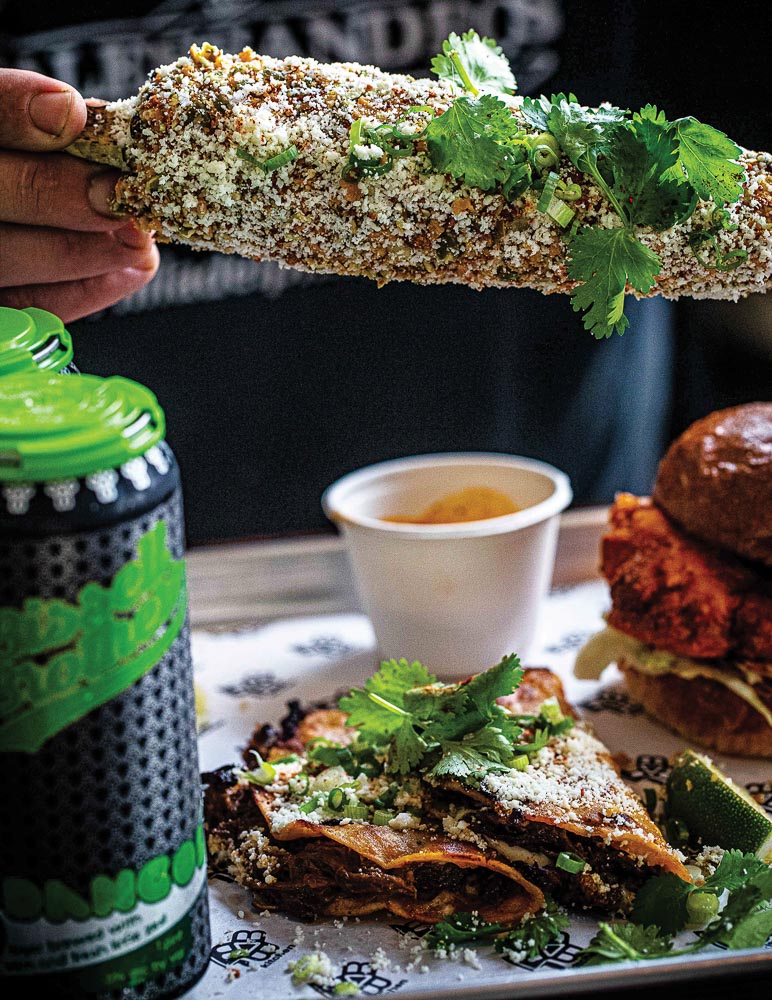By Kate McCarty
From our November 2023 issue
Chef David Rinaldi’s kitchen makes dishes like goat birria tacos, beer-battered haddock with honey-miso-butter glaze, and delicate little agnolotti pasta filled with carrot puree — creative fare that would seem right at home in a snug little restaurant with impossible-to-score reservations. But Rinaldi cooks somewhere else entirely: the sprawling Bissell Brothers taproom that seats up to 200 people, at the Thompson’s Point development in Portland. A decade ago, when Bissell Brothers was just starting out, the brewery relied on food trucks to feed guests. Lately, though, the Portland location has seemed as much a restaurant as a taproom. The Bissell Brothers outpost in Milo underwent a similar culinary transformation, as have countless other taprooms across Maine. It all feels rather familiar — like the old brewpub model is making a comeback.


Maine’s first brewpub, Gritty McDuff’s, opened in Portland in 1988. It was the second craft brewery in the state, after Geary’s, and the first where visitors could sit down and put back a pint or two. At the time, Maine law prohibited selling drinks without also operating a kitchen, facing startup breweries with two options: rapidly ramp up production and distribution or figure out how to run a restaurant and brewery at the same time. Federal Jack’s, in Kennebunkport, and Sea Dog, in Camden, came on the scene as brewpubs in the ’90s, and Sebago Brewing wasn’t far behind.
But then brewpubs fell out of style, largely owing to a couple of legislative changes: in 2009, the state started allowing breweries to sell growlers of beer direct to customers, and in 2012, started allowing breweries to sell individual pours in their taprooms. Suddenly, it was possible to make a go of it by doing some light distribution and selling beer on-site.
For some brewers, it was a point of pride to focus solely on making good beer, without the distraction of overseeing a kitchen program or the pressure of quickly scaling up. Places like Maine Beer Company, Bissell Brothers, and Oxbow were hyper-focused on perfecting their America pales ales, hazy IPAs, and Belgian-style farmhouse ales. In the past several years, though, they — and many others — have added food service to their repertoires. In short, they’re acting a lot like brewpubs.
Back in 2011, Rising Tide Brewing co-owner Heather Sanborn played a lead role in lobbying the legislature to permit the sale of taproom pours sans food service, but she has more recently come to see the benefit of having her own kitchen. “We had a great run with food trucks,” she says. “But it wasn’t something that we could control or guarantee was going to be a positive guest experience every time.”
Bissell Brothers co-owner Peter Bissell thinks customers’ expectations have evolved. “There is a pressure to continue to reinvent yourself,” he says. “Taco truck in 2015? That’s fire. But now people expect a little more. They don’t want to go outside and order tacos in the rain.”
Then there’s the reality that thousands more breweries exist across the country than even a decade ago, while bars only have so many tap lines and stores only so much shelf space. Maine Brewers’ Guild executive director Shea Cusick says the reemergent brewpub model represents “the most promise for economic growth” within the industry. Plus, she adds, for breweries in rural parts of the state, there simply aren’t many restaurants around, nor are there legions of food trucks nearby.
All in all, brewers’ reasons for dabbling as restaurateurs may vary these days, but the upshot for customers is pretty clear. On a recent visit to the Bissell Brothers taproom in Portland, I opted for the birria tacos, and the spicy consommé that accompanied the cheese-filled shells was perfectly tempered by a bright, hoppy blonde ale. Synergy is usually just hollow corporate jargon to my ears, but here, I liked its flavor.




